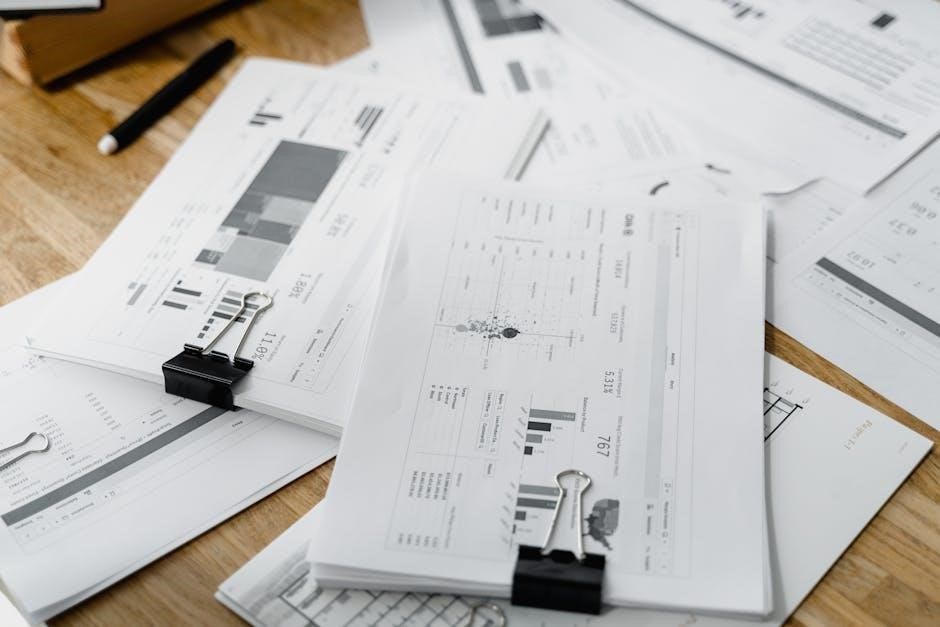Definition of Economics
Economics is the social science studying how individuals‚ businesses‚ governments‚ and societies allocate scarce resources to fulfill unlimited wants and needs. It examines human behavior in producing‚ distributing‚ and consuming goods and services. Economics explores decision-making processes under scarcity‚ emphasizing efficient resource use to maximize satisfaction. It is both a theoretical and practical field‚ offering insights into global issues like poverty‚ inequality‚ and economic growth. Through its principles‚ economics provides tools to understand financial planning‚ business strategies‚ and policy-making.
The Relevance of Economics in Everyday Life
Economics influences daily life through personal finance‚ career choices‚ and understanding societal trends. It helps individuals make informed decisions about budgeting‚ saving‚ and investing. Businesses use economic principles to set prices‚ manage resources‚ and anticipate market changes. Governments apply economics to craft policies addressing inflation‚ unemployment‚ and public welfare. By studying economics‚ people gain insights into global issues like poverty and inequality‚ enabling smarter choices in their personal and professional lives. Economics provides a framework to navigate financial uncertainties and contribute to societal well-being effectively.
Branches of Economics
Economics is divided into microeconomics and macroeconomics. Microeconomics focuses on individual economic units like households and firms‚ studying supply‚ demand‚ and market structures. Macroeconomics examines the economy as a whole‚ addressing issues like GDP‚ inflation‚ and unemployment. Additionally‚ branches like public economics analyze government policies‚ while behavioral economics explores psychological influences on decision-making. These fields provide tools to understand economic systems‚ resource allocation‚ and societal well-being‚ offering insights into global challenges and policy-making processes. Each branch contributes to a comprehensive understanding of economic dynamics and their real-world applications.
The Economic Problem
The economic problem arises from scarcity‚ where unlimited human wants exceed limited resources‚ forcing societies to make choices about production‚ distribution‚ and consumption of goods and services.
Scarcity and Its Implications
Scarcity‚ a fundamental concept in economics‚ arises because human wants are unlimited‚ while resources are limited. This imbalance necessitates choices about how to allocate resources efficiently. Scarcity explains why trade-offs are inevitable‚ as satisfying one want may mean forgoing another. It underpins the economic problem of deciding what‚ how‚ and for whom to produce. Without scarcity‚ economics as a field would not exist. Scarcity also introduces the concept of opportunity cost‚ highlighting the value of alternatives foregone when making decisions. Understanding scarcity is essential for analyzing economic behavior and resource allocation.
Opportunity Cost and Decision-Making
Opportunity cost‚ a key concept in economics‚ refers to the value of the next best alternative forfeited when making a decision. It arises due to scarce resources‚ forcing individuals‚ businesses‚ and governments to make trade-offs. Opportunity cost influences decision-making by highlighting the sacrifices made to achieve a particular goal. For example‚ investing in education may mean forgoing immediate income. Understanding opportunity cost helps in evaluating choices and allocating resources efficiently. It is not limited to financial costs but also includes time‚ effort‚ and other resources. Recognizing opportunity cost is crucial for optimal decision-making in economics.
Factors of Production
The factors of production are the resources used to create goods and services. They include land‚ labor‚ capital‚ and entrepreneurship. Land represents natural resources like raw materials and minerals. Labor involves human effort‚ skills‚ and time. Capital refers to man-made resources such as machinery‚ buildings‚ and technology. Entrepreneurship is the process of organizing these factors to produce goods and services‚ often involving risk and innovation. Understanding these factors is essential for analyzing how economies function and how resources are allocated to meet societal needs. They form the foundation of economic productivity and growth.

Economic Systems
Economic systems are frameworks for allocating resources. Capitalism‚ socialism‚ and mixed economies are primary types‚ each balancing individual freedom and government intervention to manage production and distribution.
Capitalism
Capitalism is an economic system where private entities own and operate the means of production. It relies on market forces to allocate resources‚ with prices determined by supply and demand. Key features include private property‚ free enterprise‚ and profit motive. Capitalism incentivizes innovation and efficiency but can lead to inequality and market failures. Governments may regulate markets to address monopolies and externalities. This system is widely adopted globally‚ with variations in regulation and welfare policies. It contrasts with socialism‚ emphasizing individual over collective ownership.
Socialism
Socialism is an economic system emphasizing collective ownership of the means of production‚ often by the state or workers. It aims to reduce inequality by redistributing wealth and resources. Socialist systems prioritize public welfare over profit‚ with government planning to allocate resources. While socialism promotes fairness and social equity‚ critics argue it can lead to inefficiencies and stifle innovation. Unlike capitalism‚ socialism focuses on collective benefit‚ though mixed economies often blend elements of both. It addresses issues like income disparity and access to essential services‚ fostering a more equitable society.
Mixed Economy
A mixed economy combines elements of capitalism and socialism‚ allowing private ownership and government intervention. It balances market forces with regulation to achieve social and economic goals. Private enterprises coexist with public services‚ ensuring efficiency and social welfare. Governments may regulate key industries‚ provide public goods‚ and redistribute income to reduce inequality. Mixed economies aim to harness the benefits of both systems‚ promoting innovation while addressing market failures. This hybrid model is widely adopted globally‚ offering flexibility and adaptability to diverse economic challenges.
Microeconomics
Microeconomics studies individual economic units‚ such as households and firms‚ analyzing their decision-making and interactions in specific markets to understand resource allocation and price determination.
Supply and Demand
Supply and demand is a core concept in economics‚ explaining how prices are determined in a free market. The law of demand states that as prices rise‚ quantity demanded falls‚ while the law of supply shows that higher prices lead to increased production. The intersection of supply and demand curves establishes equilibrium‚ where the quantity supplied equals the quantity demanded. Factors like consumer preferences‚ production costs‚ and technology can shift these curves‚ influencing market outcomes. Understanding supply and demand is crucial for analyzing market behaviors and predicting price trends in various industries.
Market Structures
Market structures refer to the characteristics of a market‚ influencing how firms operate and compete. Common structures include perfect competition‚ where many firms produce identical goods‚ and monopoly‚ where a single firm dominates the market. Other structures like oligopoly and monopolistic competition fall between these extremes. Each structure affects pricing‚ output‚ and innovation. Understanding market structures helps analyze how power is distributed among buyers and sellers‚ impacting efficiency and consumer welfare. These concepts are fundamental for assessing real-world markets and formulating economic policies that promote fair competition and innovation.
Consumer Behavior
Consumer behavior studies how individuals make purchasing decisions‚ influenced by preferences‚ income‚ and prices. It examines factors like utility maximization‚ budget constraints‚ and demand theory. Understanding consumer behavior helps explain market dynamics‚ such as how price changes affect demand. This knowledge is crucial for businesses to tailor products and pricing strategies. Additionally‚ it informs policymakers on taxation and welfare programs. Consumer behavior is a cornerstone of microeconomics‚ offering insights into how individuals allocate resources to achieve satisfaction and meet their needs effectively in a competitive market environment.
Macroeconomics
Macroeconomics studies the economy’s overall performance‚ focusing on GDP‚ growth‚ and inflation. It examines fiscal policy’s role in stabilizing national income and employment patterns.
Gross Domestic Product (GDP)
GDP measures a nation’s economic performance by calculating the total value of goods and services produced within its borders over a specific period. It is a key indicator of economic growth and development‚ reflecting the overall health of an economy. GDP can be calculated using expenditure‚ income‚ or production approaches. Nominal GDP measures current prices‚ while real GDP adjusts for inflation‚ providing a clearer picture of economic expansion. Understanding GDP is crucial for policymakers to assess economic stability and make informed decisions. It remains a fundamental concept in macroeconomic analysis and planning.
Inflation and Its Effects
Inflation is a sustained increase in the general price level of goods and services in an economy over time. It erodes purchasing power‚ reducing the value of money and affecting consumer budgets. Causes include demand-pull factors‚ such as excess demand‚ and cost-push factors‚ like rising production costs. Inflation can lead to uncertainty in economic planning and decreased savings value. Central banks often target inflation rates to maintain economic stability. Measuring inflation‚ typically through indices like the Consumer Price Index (CPI)‚ helps policymakers implement strategies to mitigate its adverse effects and promote economic growth.
Fiscal Policy and Its Role
Fiscal policy refers to government actions regarding spending and taxation to manage economic activity. It aims to stabilize economies during recessions or inflations by adjusting public expenditure and revenue. Tools include government spending on infrastructure‚ education‚ and healthcare‚ as well as tax rates. Fiscal policy promotes economic growth‚ reduces unemployment‚ and addresses income inequality. Effective implementation requires balancing short-term interventions with long-term fiscal sustainability to avoid debt accumulation. It plays a crucial role in shaping economic outcomes and achieving societal goals‚ making it a key instrument for policymakers.
The Importance of Economics in Daily Life
Economics influences daily decisions‚ from budgeting to shopping‚ helping individuals allocate resources efficiently and make informed financial choices to improve living standards.
Personal Financial Planning
Understanding economics aids in personal financial planning by helping individuals allocate resources efficiently. It involves budgeting‚ saving‚ and investing wisely‚ ensuring financial stability. Economics principles guide decisions on managing debt‚ understanding inflation‚ and making informed choices about spending and saving. By applying economic concepts‚ individuals can optimize their financial resources‚ achieve long-term goals‚ and improve overall financial well-being. This practical application of economics empowers people to navigate financial challenges effectively and make smarter decisions in their daily lives.
Business Decision-Making
Economics plays a crucial role in business decision-making by providing insights into market dynamics‚ consumer behavior‚ and resource allocation. Understanding supply and demand helps businesses set optimal prices and production levels. Economic principles guide investment decisions‚ cost management‚ and risk assessment. By analyzing market trends and competition‚ firms can identify opportunities and challenges; Economics also aids in evaluating the impact of external factors like inflation and government policies. This enables businesses to make informed‚ strategic choices that drive growth‚ profitability‚ and sustainability in a competitive environment.
Public Policy and Resource Allocation
Economics is essential for understanding public policy and resource allocation‚ as it evaluates how societies distribute limited resources to meet unlimited needs. Governments use economic principles to design policies that maximize societal welfare‚ ensuring efficient allocation of resources like labor‚ capital‚ and technology. By analyzing costs and benefits‚ policymakers address issues like poverty‚ inequality‚ and environmental degradation. Economic tools such as fiscal policy and cost-benefit analysis guide decision-making‚ helping to allocate resources effectively and achieve long-term developmental goals while minimizing waste and optimizing outcomes.

Economic Tools and Concepts
Economic tools include graphs‚ charts‚ and equations that analyze data‚ while concepts like scarcity and opportunity cost guide decision-making‚ aiding in understanding economic principles effectively.
Economic Graphs and Charts
Key Equations in Economics
Statistical Methods in Economic Analysis

Challenges in Economics
Economics faces challenges like globalization‚ inequality‚ and behavioral biases‚ requiring innovative solutions to address complex societal and financial issues effectively.
Globalization and Its Impact
Globalization‚ a key challenge in economics‚ refers to the increasing interconnectedness of economies worldwide. It fosters trade‚ investment‚ and cultural exchange but also leads to economic interdependence. While it promotes growth and access to global markets‚ it can exacerbate inequality‚ disrupt local industries‚ and create job displacement. Additionally‚ globalization heightens competition‚ influencing wages and labor standards. Managing its impacts requires balanced policies to ensure equitable benefits and mitigate risks‚ addressing both economic and social dimensions effectively.
Economic Inequality
Economic inequality refers to the unequal distribution of wealth‚ income‚ and resources among individuals‚ groups‚ or regions. It arises from factors like unequal access to education‚ healthcare‚ and job opportunities. High inequality can lead to social unrest‚ reduced economic growth‚ and decreased opportunities for marginalized groups. Addressing inequality requires policies such as progressive taxation‚ social welfare programs‚ and investments in education and infrastructure. Understanding economic inequality is crucial for designing policies that promote equitable development and improve overall well-being in society.
Behavioral Economics
Behavioral economics explores how psychological‚ social‚ and emotional factors influence economic decisions. It challenges traditional assumptions of rational decision-making by incorporating insights from psychology. Key concepts include cognitive biases‚ heuristics‚ and prospect theory‚ which explain why people often make irrational choices. This field helps understand phenomena like loss aversion and the endowment effect. By identifying systematic biases‚ behavioral economics informs policy design‚ such as “nudges” to promote better financial and health decisions. Its applications span finance‚ marketing‚ and public policy‚ offering a more realistic view of human behavior in economic contexts.
Resources for Learning Economics
Recommended Textbooks
by Daron Acemoglu and CBSE Class 11 Economics revision notes are also valuable. These materials provide foundational knowledge and practical insights for students and enthusiasts alike.
Online Courses and Tutorials
Online courses and tutorials provide accessible learning opportunities in economics. Platforms offer resources like ECON 101‚ introducing fundamental concepts. The University of Minnesota Libraries publishes a free online textbook in PDF format‚ covering standard topics. Additionally‚ CBSE Class 11 Economics revision notes and resources from platforms like Godson Blog and eGyanKosh are available. These materials are designed to help students and enthusiasts grasp economic principles effectively‚ making them ideal for self-study or supplementary learning.
Research Papers and Journals
Research papers and journals offer in-depth insights into economic theories and applications. Resources like ResearchGate provide access to scholarly articles and research on economics. PDF documents‚ such as those from the University of Calicut and New Prairie Press‚ cover topics like scarcity‚ economic systems‚ and advanced analysis. These materials are essential for understanding current trends and complex economic concepts‚ making them valuable for students and researchers seeking detailed knowledge in the field of economics.
Economics is crucial for understanding resource allocation‚ decision-making‚ and societal well-being. This introduction provides a foundation for further study‚ with PDF resources offering detailed insights into key concepts.
Economics is the study of choice and scarcity‚ focusing on how resources are allocated to meet unlimited wants and needs. Key concepts include microeconomics (individual decisions) and macroeconomics (broader economic systems). The economic problem revolves around scarcity‚ choice‚ and opportunity cost. Understanding these principles helps in analyzing markets‚ consumer behavior‚ and policy-making. Economics also explores systems like capitalism‚ socialism‚ and mixed economies‚ providing tools to evaluate efficiency and equity in resource use. These concepts are essential for personal finance‚ business strategies‚ and public policy decisions‚ making economics a vital field for everyday life and global challenges.
Future Trends in Economics
Future trends in economics include the rise of automation‚ artificial intelligence‚ and blockchain technology‚ reshaping labor markets and financial systems. Sustainability and climate economics will gain prominence as global priorities shift toward environmental conservation. Behavioral economics will further influence policy-making by understanding human decision-making biases. Globalization and digitalization will continue to interconnect economies‚ creating new opportunities and challenges. These trends highlight the evolving nature of economics‚ emphasizing the need for adaptive policies and innovative solutions to address future societal and economic challenges effectively.

How to Prepare for Economics Exams
Understand key concepts like scarcity‚ opportunity cost‚ and supply-demand. Practice past papers‚ focus on graphs‚ and review class notes. Use flashcards for terminology and seek clarification on doubts.
Study Tips and Strategies
To excel in economics exams‚ focus on understanding key concepts like scarcity‚ opportunity cost‚ and supply-demand dynamics. Regularly review notes and textbooks‚ and practice solving graphs. Use flashcards to memorize terminology and formulas. Engage with past papers to familiarize yourself with exam formats. Participate in study groups to discuss complex topics. Seek clarification from instructors on difficult concepts. Apply economic principles to real-world scenarios to enhance understanding. Stay organized and allocate dedicated time for revision. Consistent practice and critical thinking are essential for success in economics exams.
Practice Questions and Past Papers
Practicing with past exam papers and sample questions is crucial for mastering economics. These resources help familiarize students with exam formats and timing. Focus on solving questions related to key topics like supply and demand‚ GDP‚ and fiscal policy. Use online platforms and educational websites to access PDFs of past papers and practice exercises. Regularly attempting these questions enhances problem-solving skills and confidence. Review answers to understand mistakes and improve understanding of economic concepts. Consistent practice ensures better performance in exams.